Examining the role of Tourism
VerifiedAdded on 2022/09/14
|8
|1953
|13
AI Summary
Contribute Materials
Your contribution can guide someone’s learning journey. Share your
documents today.
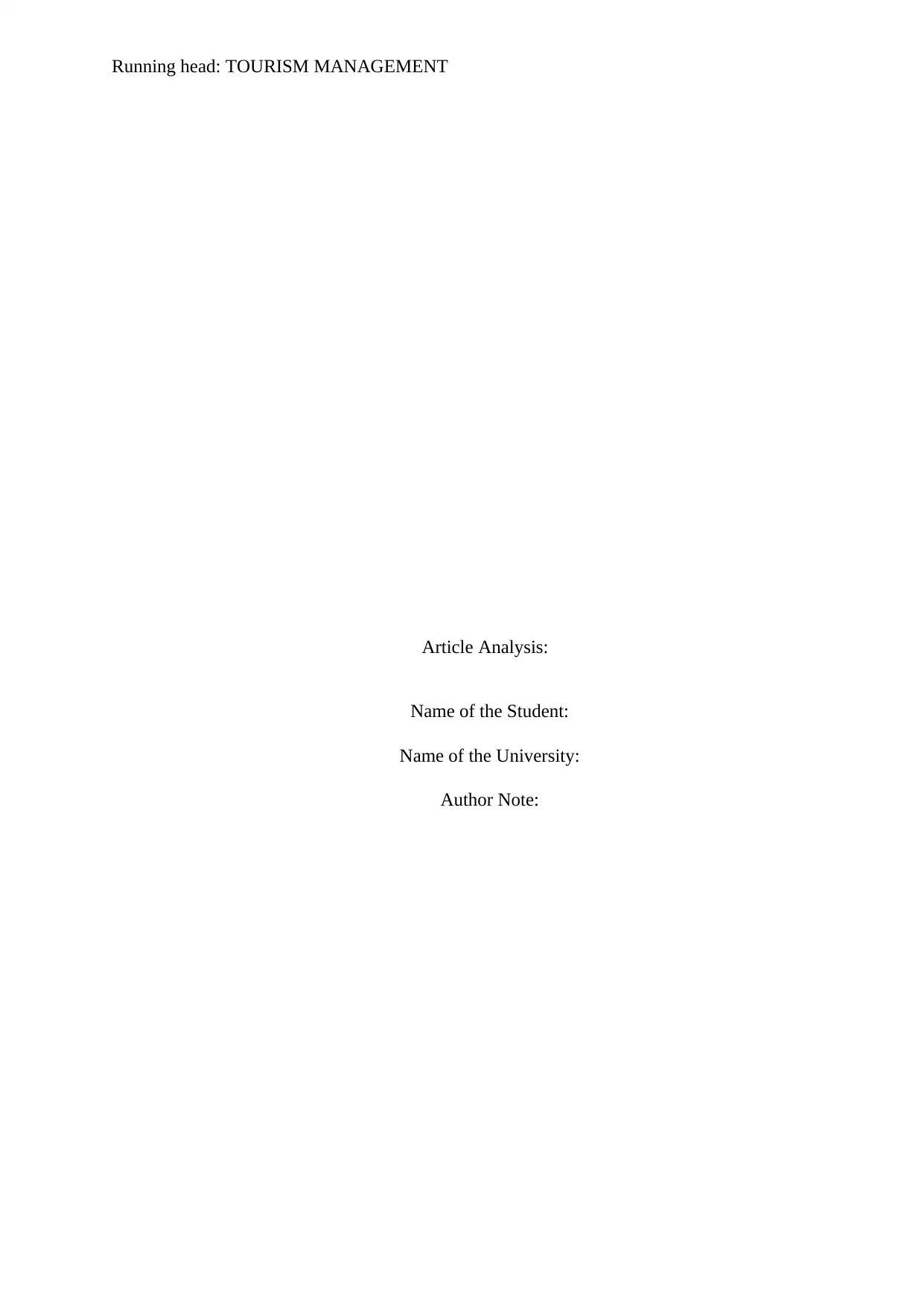
Running head: TOURISM MANAGEMENT
Article Analysis:
Name of the Student:
Name of the University:
Author Note:
Article Analysis:
Name of the Student:
Name of the University:
Author Note:
Secure Best Marks with AI Grader
Need help grading? Try our AI Grader for instant feedback on your assignments.
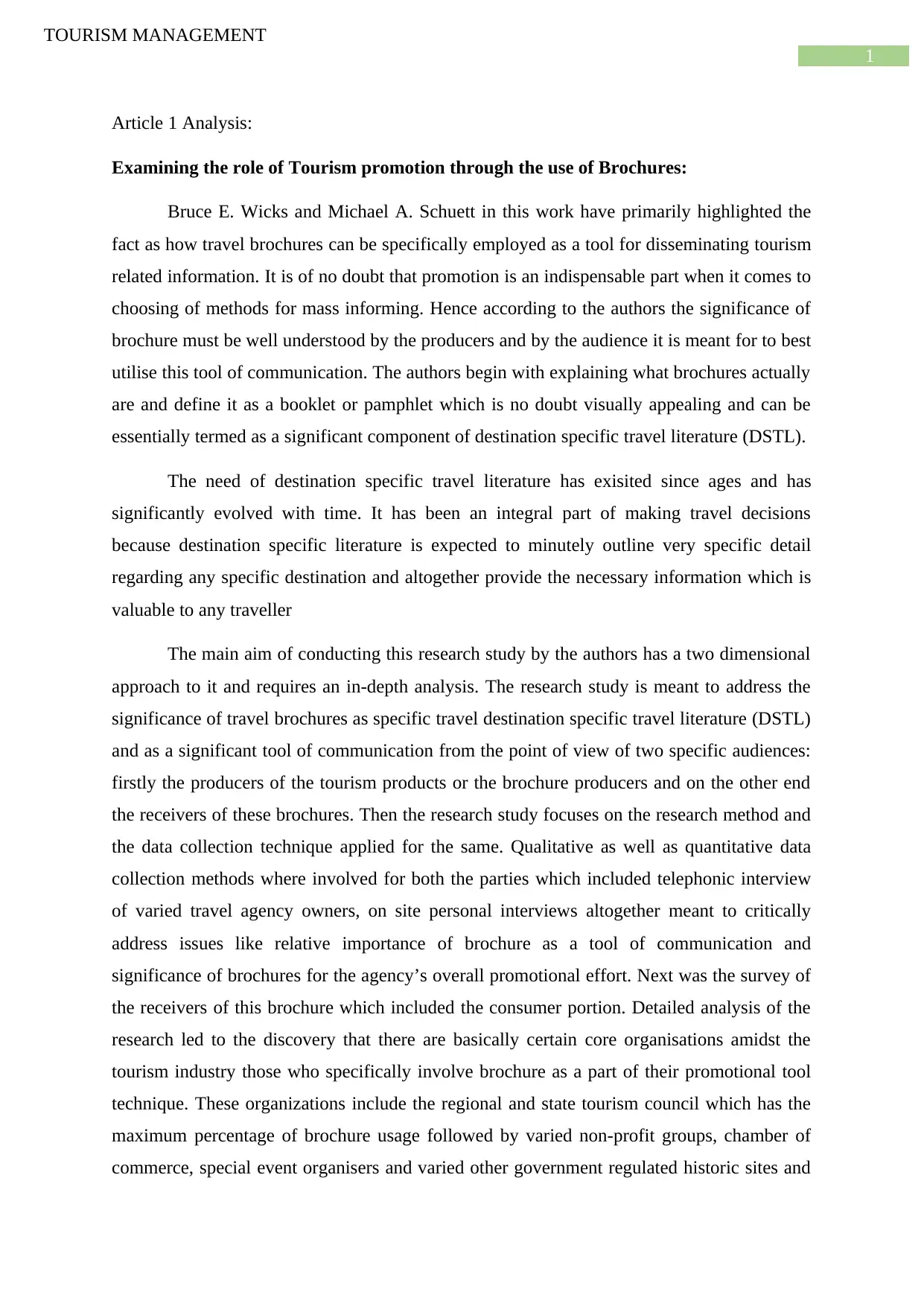
1
TOURISM MANAGEMENT
Article 1 Analysis:
Examining the role of Tourism promotion through the use of Brochures:
Bruce E. Wicks and Michael A. Schuett in this work have primarily highlighted the
fact as how travel brochures can be specifically employed as a tool for disseminating tourism
related information. It is of no doubt that promotion is an indispensable part when it comes to
choosing of methods for mass informing. Hence according to the authors the significance of
brochure must be well understood by the producers and by the audience it is meant for to best
utilise this tool of communication. The authors begin with explaining what brochures actually
are and define it as a booklet or pamphlet which is no doubt visually appealing and can be
essentially termed as a significant component of destination specific travel literature (DSTL).
The need of destination specific travel literature has exisited since ages and has
significantly evolved with time. It has been an integral part of making travel decisions
because destination specific literature is expected to minutely outline very specific detail
regarding any specific destination and altogether provide the necessary information which is
valuable to any traveller
The main aim of conducting this research study by the authors has a two dimensional
approach to it and requires an in-depth analysis. The research study is meant to address the
significance of travel brochures as specific travel destination specific travel literature (DSTL)
and as a significant tool of communication from the point of view of two specific audiences:
firstly the producers of the tourism products or the brochure producers and on the other end
the receivers of these brochures. Then the research study focuses on the research method and
the data collection technique applied for the same. Qualitative as well as quantitative data
collection methods where involved for both the parties which included telephonic interview
of varied travel agency owners, on site personal interviews altogether meant to critically
address issues like relative importance of brochure as a tool of communication and
significance of brochures for the agency’s overall promotional effort. Next was the survey of
the receivers of this brochure which included the consumer portion. Detailed analysis of the
research led to the discovery that there are basically certain core organisations amidst the
tourism industry those who specifically involve brochure as a part of their promotional tool
technique. These organizations include the regional and state tourism council which has the
maximum percentage of brochure usage followed by varied non-profit groups, chamber of
commerce, special event organisers and varied other government regulated historic sites and
TOURISM MANAGEMENT
Article 1 Analysis:
Examining the role of Tourism promotion through the use of Brochures:
Bruce E. Wicks and Michael A. Schuett in this work have primarily highlighted the
fact as how travel brochures can be specifically employed as a tool for disseminating tourism
related information. It is of no doubt that promotion is an indispensable part when it comes to
choosing of methods for mass informing. Hence according to the authors the significance of
brochure must be well understood by the producers and by the audience it is meant for to best
utilise this tool of communication. The authors begin with explaining what brochures actually
are and define it as a booklet or pamphlet which is no doubt visually appealing and can be
essentially termed as a significant component of destination specific travel literature (DSTL).
The need of destination specific travel literature has exisited since ages and has
significantly evolved with time. It has been an integral part of making travel decisions
because destination specific literature is expected to minutely outline very specific detail
regarding any specific destination and altogether provide the necessary information which is
valuable to any traveller
The main aim of conducting this research study by the authors has a two dimensional
approach to it and requires an in-depth analysis. The research study is meant to address the
significance of travel brochures as specific travel destination specific travel literature (DSTL)
and as a significant tool of communication from the point of view of two specific audiences:
firstly the producers of the tourism products or the brochure producers and on the other end
the receivers of these brochures. Then the research study focuses on the research method and
the data collection technique applied for the same. Qualitative as well as quantitative data
collection methods where involved for both the parties which included telephonic interview
of varied travel agency owners, on site personal interviews altogether meant to critically
address issues like relative importance of brochure as a tool of communication and
significance of brochures for the agency’s overall promotional effort. Next was the survey of
the receivers of this brochure which included the consumer portion. Detailed analysis of the
research led to the discovery that there are basically certain core organisations amidst the
tourism industry those who specifically involve brochure as a part of their promotional tool
technique. These organizations include the regional and state tourism council which has the
maximum percentage of brochure usage followed by varied non-profit groups, chamber of
commerce, special event organisers and varied other government regulated historic sites and
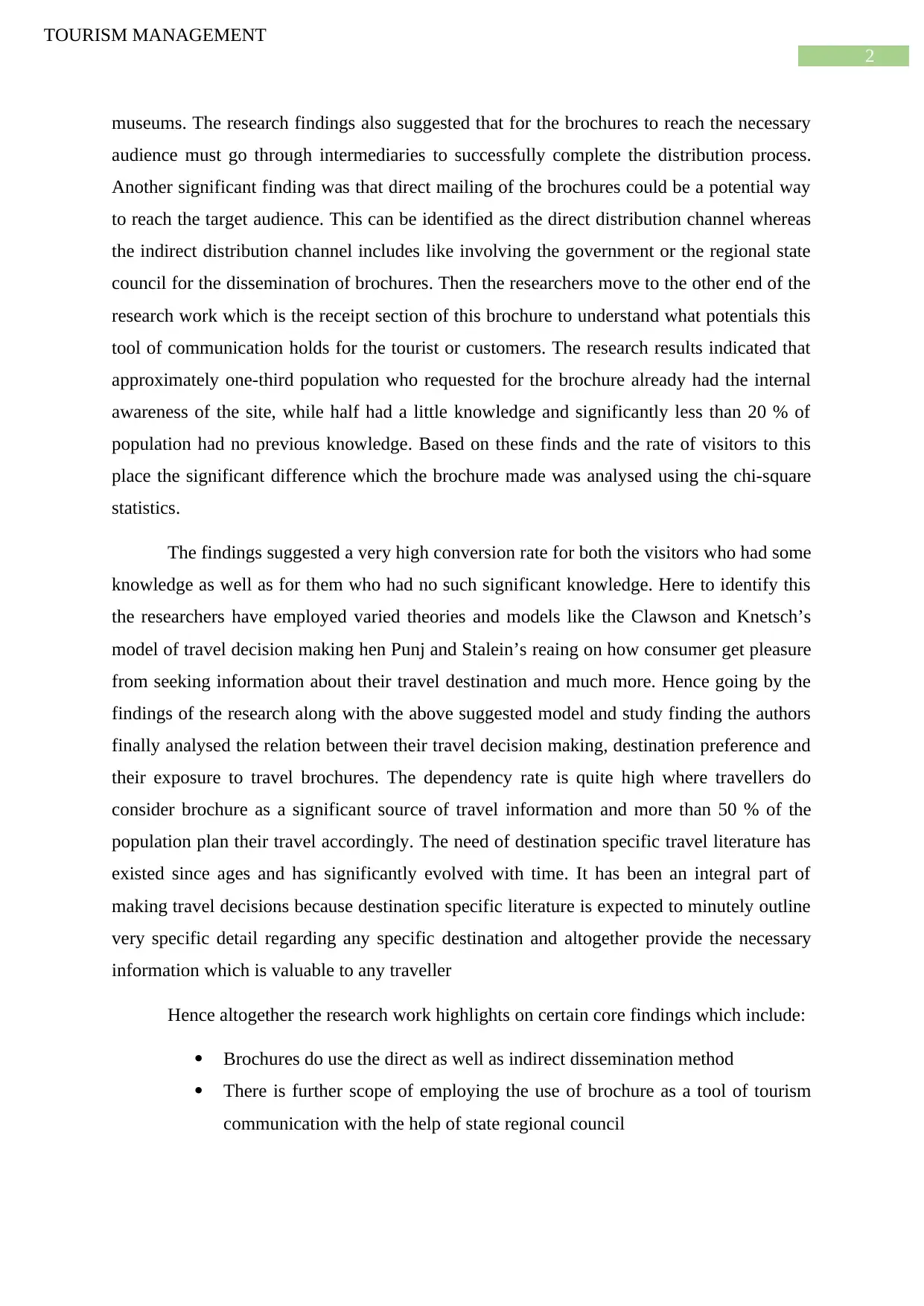
2
TOURISM MANAGEMENT
museums. The research findings also suggested that for the brochures to reach the necessary
audience must go through intermediaries to successfully complete the distribution process.
Another significant finding was that direct mailing of the brochures could be a potential way
to reach the target audience. This can be identified as the direct distribution channel whereas
the indirect distribution channel includes like involving the government or the regional state
council for the dissemination of brochures. Then the researchers move to the other end of the
research work which is the receipt section of this brochure to understand what potentials this
tool of communication holds for the tourist or customers. The research results indicated that
approximately one-third population who requested for the brochure already had the internal
awareness of the site, while half had a little knowledge and significantly less than 20 % of
population had no previous knowledge. Based on these finds and the rate of visitors to this
place the significant difference which the brochure made was analysed using the chi-square
statistics.
The findings suggested a very high conversion rate for both the visitors who had some
knowledge as well as for them who had no such significant knowledge. Here to identify this
the researchers have employed varied theories and models like the Clawson and Knetsch’s
model of travel decision making hen Punj and Stalein’s reaing on how consumer get pleasure
from seeking information about their travel destination and much more. Hence going by the
findings of the research along with the above suggested model and study finding the authors
finally analysed the relation between their travel decision making, destination preference and
their exposure to travel brochures. The dependency rate is quite high where travellers do
consider brochure as a significant source of travel information and more than 50 % of the
population plan their travel accordingly. The need of destination specific travel literature has
existed since ages and has significantly evolved with time. It has been an integral part of
making travel decisions because destination specific literature is expected to minutely outline
very specific detail regarding any specific destination and altogether provide the necessary
information which is valuable to any traveller
Hence altogether the research work highlights on certain core findings which include:
Brochures do use the direct as well as indirect dissemination method
There is further scope of employing the use of brochure as a tool of tourism
communication with the help of state regional council
TOURISM MANAGEMENT
museums. The research findings also suggested that for the brochures to reach the necessary
audience must go through intermediaries to successfully complete the distribution process.
Another significant finding was that direct mailing of the brochures could be a potential way
to reach the target audience. This can be identified as the direct distribution channel whereas
the indirect distribution channel includes like involving the government or the regional state
council for the dissemination of brochures. Then the researchers move to the other end of the
research work which is the receipt section of this brochure to understand what potentials this
tool of communication holds for the tourist or customers. The research results indicated that
approximately one-third population who requested for the brochure already had the internal
awareness of the site, while half had a little knowledge and significantly less than 20 % of
population had no previous knowledge. Based on these finds and the rate of visitors to this
place the significant difference which the brochure made was analysed using the chi-square
statistics.
The findings suggested a very high conversion rate for both the visitors who had some
knowledge as well as for them who had no such significant knowledge. Here to identify this
the researchers have employed varied theories and models like the Clawson and Knetsch’s
model of travel decision making hen Punj and Stalein’s reaing on how consumer get pleasure
from seeking information about their travel destination and much more. Hence going by the
findings of the research along with the above suggested model and study finding the authors
finally analysed the relation between their travel decision making, destination preference and
their exposure to travel brochures. The dependency rate is quite high where travellers do
consider brochure as a significant source of travel information and more than 50 % of the
population plan their travel accordingly. The need of destination specific travel literature has
existed since ages and has significantly evolved with time. It has been an integral part of
making travel decisions because destination specific literature is expected to minutely outline
very specific detail regarding any specific destination and altogether provide the necessary
information which is valuable to any traveller
Hence altogether the research work highlights on certain core findings which include:
Brochures do use the direct as well as indirect dissemination method
There is further scope of employing the use of brochure as a tool of tourism
communication with the help of state regional council
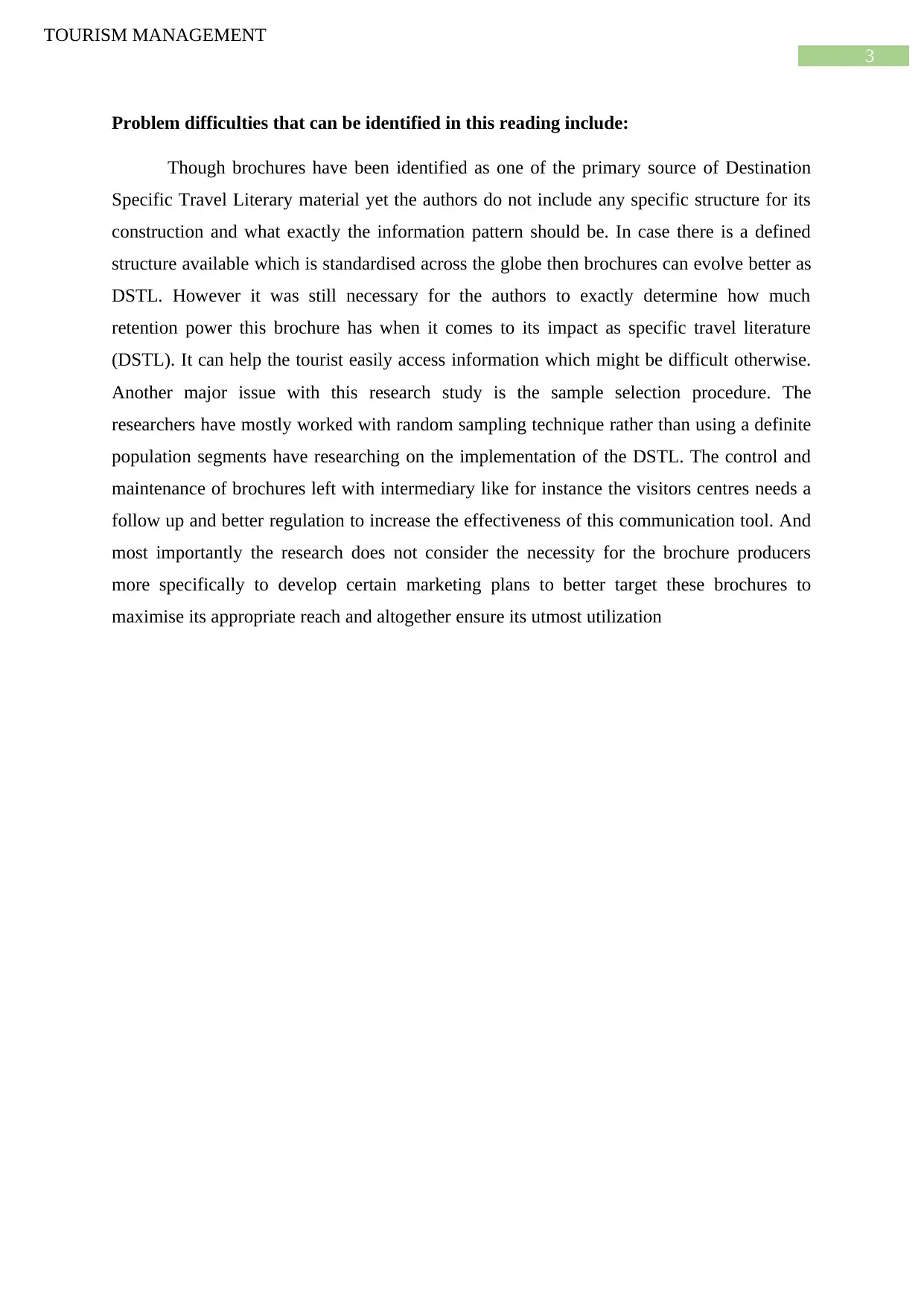
3
TOURISM MANAGEMENT
Problem difficulties that can be identified in this reading include:
Though brochures have been identified as one of the primary source of Destination
Specific Travel Literary material yet the authors do not include any specific structure for its
construction and what exactly the information pattern should be. In case there is a defined
structure available which is standardised across the globe then brochures can evolve better as
DSTL. However it was still necessary for the authors to exactly determine how much
retention power this brochure has when it comes to its impact as specific travel literature
(DSTL). It can help the tourist easily access information which might be difficult otherwise.
Another major issue with this research study is the sample selection procedure. The
researchers have mostly worked with random sampling technique rather than using a definite
population segments have researching on the implementation of the DSTL. The control and
maintenance of brochures left with intermediary like for instance the visitors centres needs a
follow up and better regulation to increase the effectiveness of this communication tool. And
most importantly the research does not consider the necessity for the brochure producers
more specifically to develop certain marketing plans to better target these brochures to
maximise its appropriate reach and altogether ensure its utmost utilization
TOURISM MANAGEMENT
Problem difficulties that can be identified in this reading include:
Though brochures have been identified as one of the primary source of Destination
Specific Travel Literary material yet the authors do not include any specific structure for its
construction and what exactly the information pattern should be. In case there is a defined
structure available which is standardised across the globe then brochures can evolve better as
DSTL. However it was still necessary for the authors to exactly determine how much
retention power this brochure has when it comes to its impact as specific travel literature
(DSTL). It can help the tourist easily access information which might be difficult otherwise.
Another major issue with this research study is the sample selection procedure. The
researchers have mostly worked with random sampling technique rather than using a definite
population segments have researching on the implementation of the DSTL. The control and
maintenance of brochures left with intermediary like for instance the visitors centres needs a
follow up and better regulation to increase the effectiveness of this communication tool. And
most importantly the research does not consider the necessity for the brochure producers
more specifically to develop certain marketing plans to better target these brochures to
maximise its appropriate reach and altogether ensure its utmost utilization
Secure Best Marks with AI Grader
Need help grading? Try our AI Grader for instant feedback on your assignments.
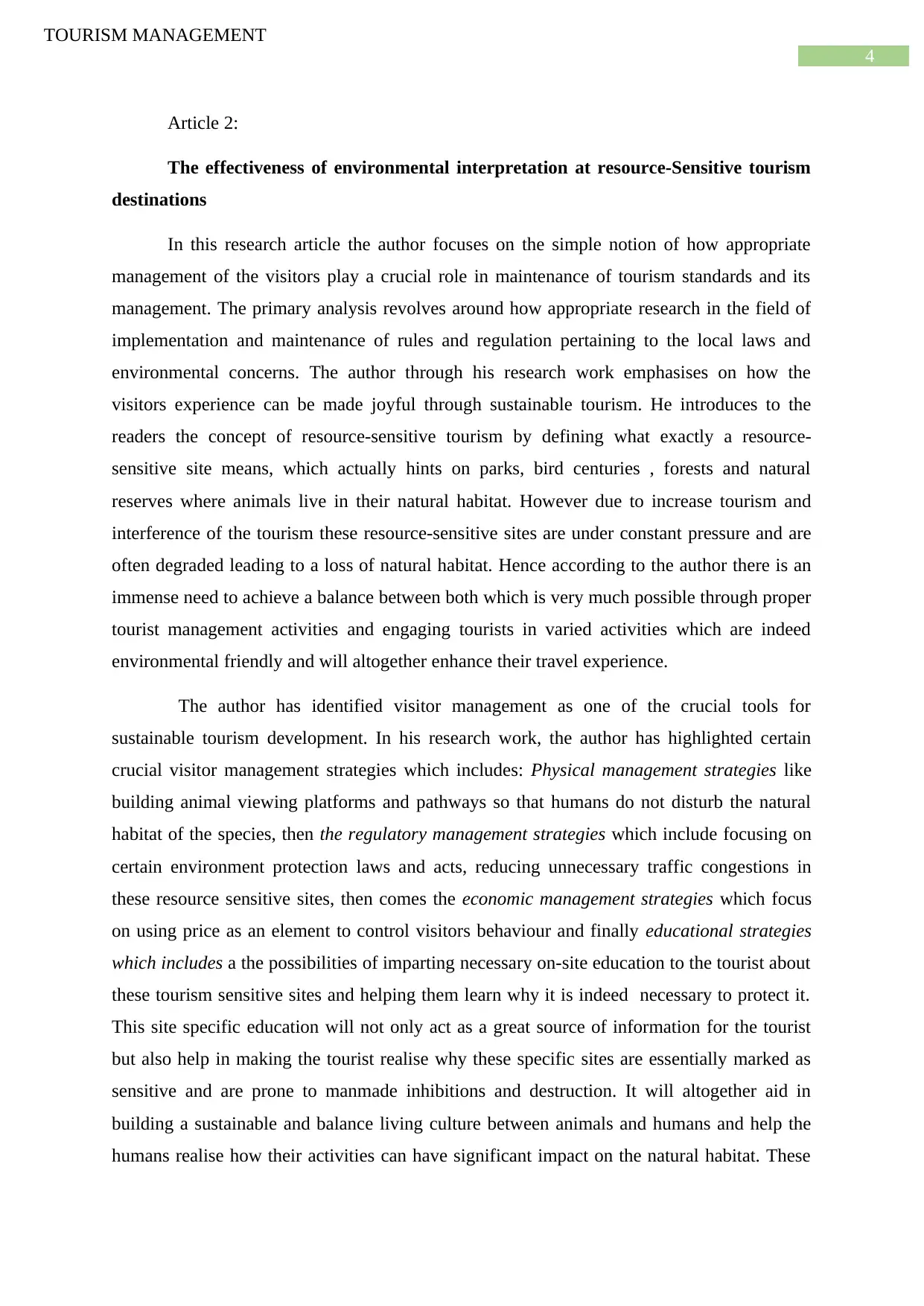
4
TOURISM MANAGEMENT
Article 2:
The effectiveness of environmental interpretation at resource‐Sensitive tourism
destinations
In this research article the author focuses on the simple notion of how appropriate
management of the visitors play a crucial role in maintenance of tourism standards and its
management. The primary analysis revolves around how appropriate research in the field of
implementation and maintenance of rules and regulation pertaining to the local laws and
environmental concerns. The author through his research work emphasises on how the
visitors experience can be made joyful through sustainable tourism. He introduces to the
readers the concept of resource-sensitive tourism by defining what exactly a resource-
sensitive site means, which actually hints on parks, bird centuries , forests and natural
reserves where animals live in their natural habitat. However due to increase tourism and
interference of the tourism these resource-sensitive sites are under constant pressure and are
often degraded leading to a loss of natural habitat. Hence according to the author there is an
immense need to achieve a balance between both which is very much possible through proper
tourist management activities and engaging tourists in varied activities which are indeed
environmental friendly and will altogether enhance their travel experience.
The author has identified visitor management as one of the crucial tools for
sustainable tourism development. In his research work, the author has highlighted certain
crucial visitor management strategies which includes: Physical management strategies like
building animal viewing platforms and pathways so that humans do not disturb the natural
habitat of the species, then the regulatory management strategies which include focusing on
certain environment protection laws and acts, reducing unnecessary traffic congestions in
these resource sensitive sites, then comes the economic management strategies which focus
on using price as an element to control visitors behaviour and finally educational strategies
which includes a the possibilities of imparting necessary on-site education to the tourist about
these tourism sensitive sites and helping them learn why it is indeed necessary to protect it.
This site specific education will not only act as a great source of information for the tourist
but also help in making the tourist realise why these specific sites are essentially marked as
sensitive and are prone to manmade inhibitions and destruction. It will altogether aid in
building a sustainable and balance living culture between animals and humans and help the
humans realise how their activities can have significant impact on the natural habitat. These
TOURISM MANAGEMENT
Article 2:
The effectiveness of environmental interpretation at resource‐Sensitive tourism
destinations
In this research article the author focuses on the simple notion of how appropriate
management of the visitors play a crucial role in maintenance of tourism standards and its
management. The primary analysis revolves around how appropriate research in the field of
implementation and maintenance of rules and regulation pertaining to the local laws and
environmental concerns. The author through his research work emphasises on how the
visitors experience can be made joyful through sustainable tourism. He introduces to the
readers the concept of resource-sensitive tourism by defining what exactly a resource-
sensitive site means, which actually hints on parks, bird centuries , forests and natural
reserves where animals live in their natural habitat. However due to increase tourism and
interference of the tourism these resource-sensitive sites are under constant pressure and are
often degraded leading to a loss of natural habitat. Hence according to the author there is an
immense need to achieve a balance between both which is very much possible through proper
tourist management activities and engaging tourists in varied activities which are indeed
environmental friendly and will altogether enhance their travel experience.
The author has identified visitor management as one of the crucial tools for
sustainable tourism development. In his research work, the author has highlighted certain
crucial visitor management strategies which includes: Physical management strategies like
building animal viewing platforms and pathways so that humans do not disturb the natural
habitat of the species, then the regulatory management strategies which include focusing on
certain environment protection laws and acts, reducing unnecessary traffic congestions in
these resource sensitive sites, then comes the economic management strategies which focus
on using price as an element to control visitors behaviour and finally educational strategies
which includes a the possibilities of imparting necessary on-site education to the tourist about
these tourism sensitive sites and helping them learn why it is indeed necessary to protect it.
This site specific education will not only act as a great source of information for the tourist
but also help in making the tourist realise why these specific sites are essentially marked as
sensitive and are prone to manmade inhibitions and destruction. It will altogether aid in
building a sustainable and balance living culture between animals and humans and help the
humans realise how their activities can have significant impact on the natural habitat. These
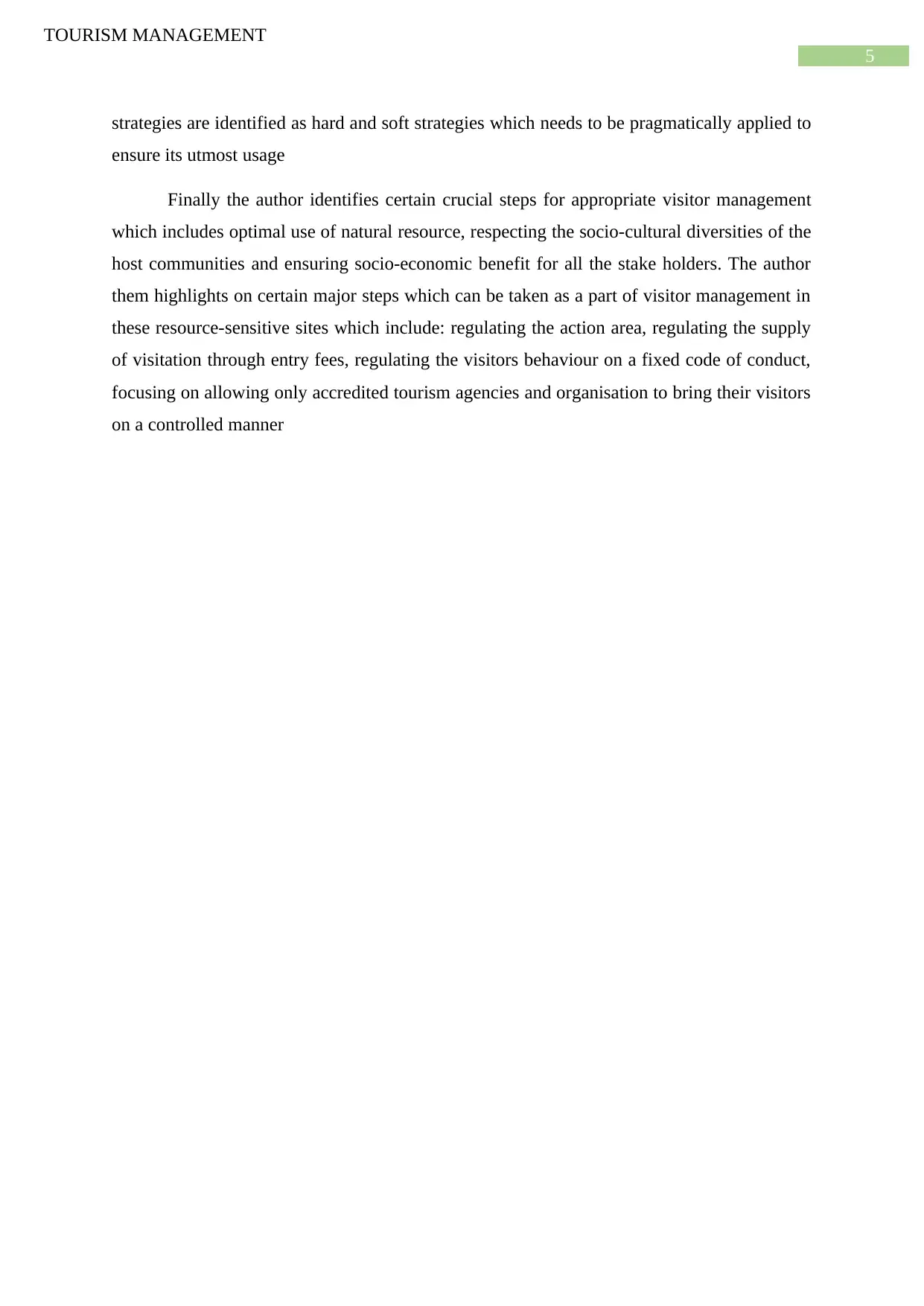
5
TOURISM MANAGEMENT
strategies are identified as hard and soft strategies which needs to be pragmatically applied to
ensure its utmost usage
Finally the author identifies certain crucial steps for appropriate visitor management
which includes optimal use of natural resource, respecting the socio-cultural diversities of the
host communities and ensuring socio-economic benefit for all the stake holders. The author
them highlights on certain major steps which can be taken as a part of visitor management in
these resource-sensitive sites which include: regulating the action area, regulating the supply
of visitation through entry fees, regulating the visitors behaviour on a fixed code of conduct,
focusing on allowing only accredited tourism agencies and organisation to bring their visitors
on a controlled manner
TOURISM MANAGEMENT
strategies are identified as hard and soft strategies which needs to be pragmatically applied to
ensure its utmost usage
Finally the author identifies certain crucial steps for appropriate visitor management
which includes optimal use of natural resource, respecting the socio-cultural diversities of the
host communities and ensuring socio-economic benefit for all the stake holders. The author
them highlights on certain major steps which can be taken as a part of visitor management in
these resource-sensitive sites which include: regulating the action area, regulating the supply
of visitation through entry fees, regulating the visitors behaviour on a fixed code of conduct,
focusing on allowing only accredited tourism agencies and organisation to bring their visitors
on a controlled manner
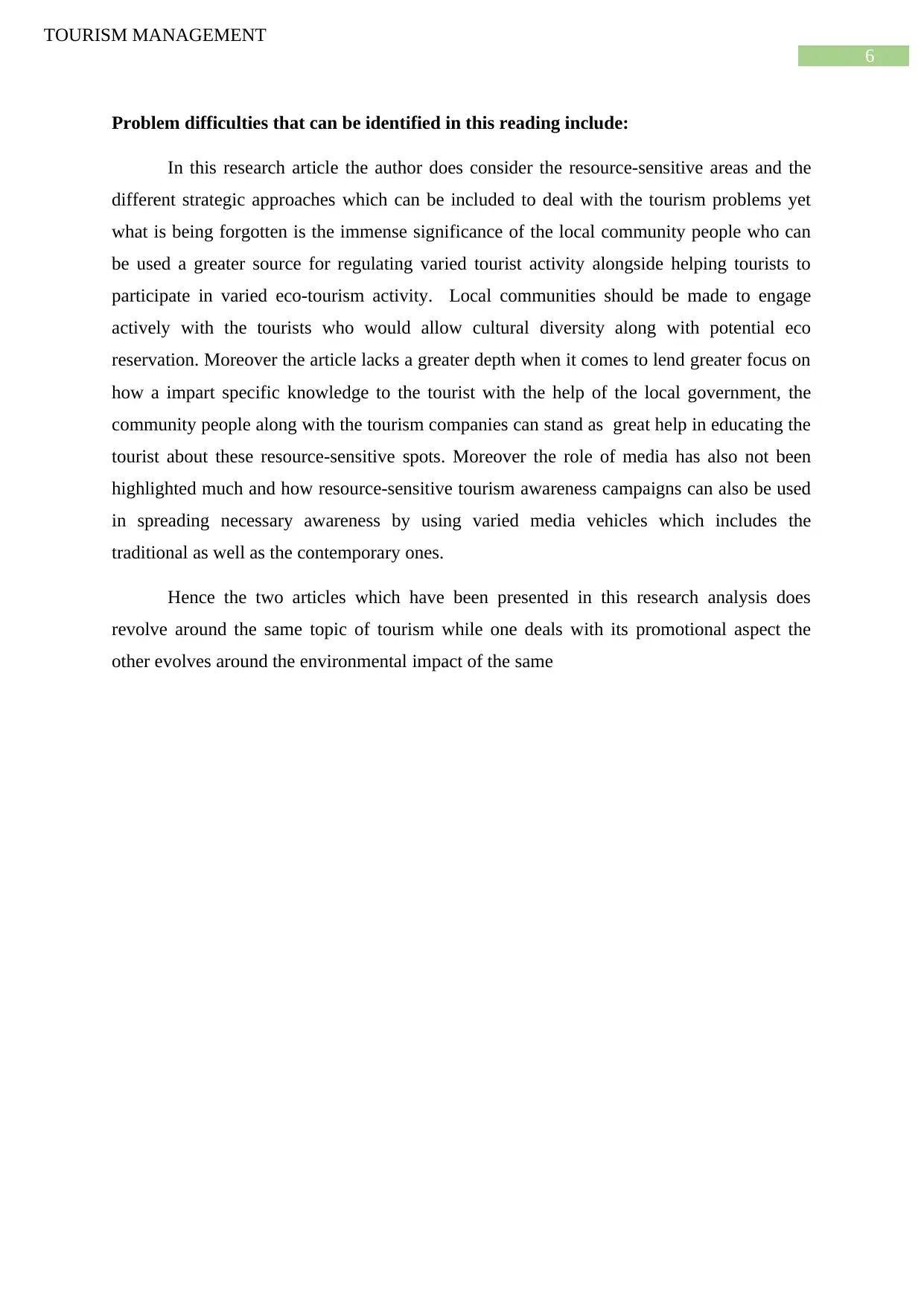
6
TOURISM MANAGEMENT
Problem difficulties that can be identified in this reading include:
In this research article the author does consider the resource-sensitive areas and the
different strategic approaches which can be included to deal with the tourism problems yet
what is being forgotten is the immense significance of the local community people who can
be used a greater source for regulating varied tourist activity alongside helping tourists to
participate in varied eco-tourism activity. Local communities should be made to engage
actively with the tourists who would allow cultural diversity along with potential eco
reservation. Moreover the article lacks a greater depth when it comes to lend greater focus on
how a impart specific knowledge to the tourist with the help of the local government, the
community people along with the tourism companies can stand as great help in educating the
tourist about these resource-sensitive spots. Moreover the role of media has also not been
highlighted much and how resource-sensitive tourism awareness campaigns can also be used
in spreading necessary awareness by using varied media vehicles which includes the
traditional as well as the contemporary ones.
Hence the two articles which have been presented in this research analysis does
revolve around the same topic of tourism while one deals with its promotional aspect the
other evolves around the environmental impact of the same
TOURISM MANAGEMENT
Problem difficulties that can be identified in this reading include:
In this research article the author does consider the resource-sensitive areas and the
different strategic approaches which can be included to deal with the tourism problems yet
what is being forgotten is the immense significance of the local community people who can
be used a greater source for regulating varied tourist activity alongside helping tourists to
participate in varied eco-tourism activity. Local communities should be made to engage
actively with the tourists who would allow cultural diversity along with potential eco
reservation. Moreover the article lacks a greater depth when it comes to lend greater focus on
how a impart specific knowledge to the tourist with the help of the local government, the
community people along with the tourism companies can stand as great help in educating the
tourist about these resource-sensitive spots. Moreover the role of media has also not been
highlighted much and how resource-sensitive tourism awareness campaigns can also be used
in spreading necessary awareness by using varied media vehicles which includes the
traditional as well as the contemporary ones.
Hence the two articles which have been presented in this research analysis does
revolve around the same topic of tourism while one deals with its promotional aspect the
other evolves around the environmental impact of the same
Paraphrase This Document
Need a fresh take? Get an instant paraphrase of this document with our AI Paraphraser
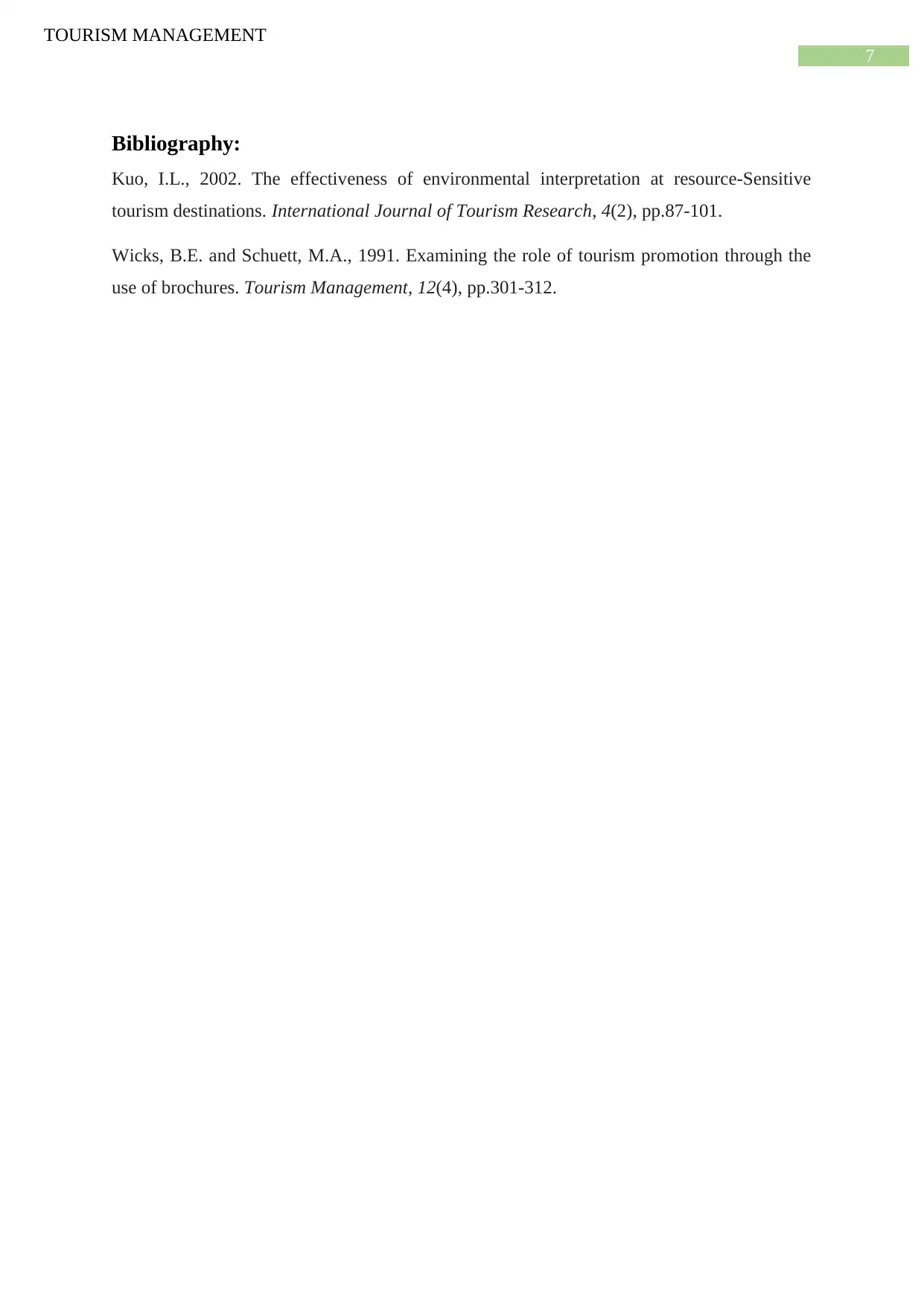
7
TOURISM MANAGEMENT
Bibliography:
Kuo, I.L., 2002. The effectiveness of environmental interpretation at resource‐Sensitive
tourism destinations. International Journal of Tourism Research, 4(2), pp.87-101.
Wicks, B.E. and Schuett, M.A., 1991. Examining the role of tourism promotion through the
use of brochures. Tourism Management, 12(4), pp.301-312.
TOURISM MANAGEMENT
Bibliography:
Kuo, I.L., 2002. The effectiveness of environmental interpretation at resource‐Sensitive
tourism destinations. International Journal of Tourism Research, 4(2), pp.87-101.
Wicks, B.E. and Schuett, M.A., 1991. Examining the role of tourism promotion through the
use of brochures. Tourism Management, 12(4), pp.301-312.
1 out of 8
Related Documents
Your All-in-One AI-Powered Toolkit for Academic Success.
+13062052269
info@desklib.com
Available 24*7 on WhatsApp / Email
![[object Object]](/_next/static/media/star-bottom.7253800d.svg)
Unlock your academic potential
© 2024 | Zucol Services PVT LTD | All rights reserved.





